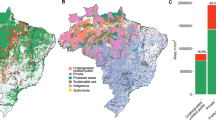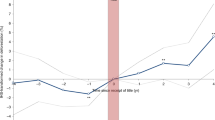Abstract
The impact of land tenure security on tropical deforestation and land management, more generally, is an issue that has received a great deal of discussion, and which possesses significant policy implications. If land tenure encourages planning over the long term, then the awarding of titles and the enforcement of private property rights may provide a decentralized approach to controlling rapid loss of forest. The economic theory on the role of tenure security on the management of assets such as land is well articulated, and in the case of tropical forest predicts a reduction in forest exploitation and destruction. Despite the conceptual appeal of the theoretical argument, little empirical work has been accomplished addressing specifically the role of secure land tenure on rates of forest clearance in tropical frontiers. The present chapter seeks to rectify this situation by combining data from a detailed survey of households with a time series of classified satellite images. In the summer of 1996, the authors conducted a survey along the Transamazon Highway in the state of Pará, Brazil, compiling information from 347 lots belonging to small-holders. In addition to the survey, they compiled a six year time-series of classified Landsat TM images for an 11-year period between 1986 and 1997 (1986, 1987, 1988, 1991, 1992, 1997). These images cover the survey area and provide a dynamic account of the land cover changes for a sub-sample of the lots queried in the original survey. The chapter gives an account of the survey sample, and results of a statistical analysis addressing the impact of title on the commercial exploitation of hardwoods and on rates of deforestation. Given knowledge of the year of titling and a series of images bracketing 11 -years, the research considers, on a lot-by-lot basis, rates of deforestation before and after the awarding of title. The paper is concludes with a discussion of the implications of findings for policy.
Access this chapter
Tax calculation will be finalised at checkout
Purchases are for personal use only
Preview
Unable to display preview. Download preview PDF.
Similar content being viewed by others
References
Alston, L.J. 1996. Empirical work in institutional economics: An overview. In Empirical Studies in Institutional Change. (Eds.) L.J. Alston; T. Eggertsson, and D.C. North, pp. 25–58. Cambridge: Cambridge University Press.
Alston, L, J.; Libecap, Gary, D., and Schneider, Robert. 1995, Property rights and the preconditions for markets: The case of the Amazon frontier. Journal of International and Theoretical Economics. 151(1): 89–107
Alston, L, J.; Libecap, Gary, D.; Mueller, Bernardo. 1997. Violence and the development of property rights to land in the Brazilian Amazon. In The Frontiers of the New Institutional Economics. John, N. Drobak and John V.C. Nye (eds.) Pp. 145–163. Academic Press.
Arnold, J.E.M. 1983. Economic considerations in agroforestry projects. Agroforestry Systems 1: 299–311.
Barnum, H.N. and Squire, L. 1979. A Model of an Agricultural Household: Theory and Evidence. Baltimore, MD: The John Hopkins University Press.
Beaumont, P. And Walker, R. 1996. Land degradation and property regimes Ecological Economics 18: 55–66.
Clark, C.W. 1973. Profit maximization and the extinction of animals. Journal of Political Economy 81: 950–961.
Clark, C. W. 1976. Mathematical Bioeconomics: The Optimal Management of Renewable Resources. New York: John Wiley & Sons.
Clark, C. W. 1985. Bioeconomic Modelling and Fisheries Management. New York: John Wiley & Sons.
Dale, Virginia, H., O’Neill, Robert V., Pedlowski, Marcos, and Southworth, Frank. 1993. Causes and effects of land-use change in central Rondonia, Brazil. Photogrammetric Engineering and Remote Sensing 59(6): 997–1005.
Dove, M. 1986. The ideology of agricultural development in Indonesia. In Central government and Local Development in Indonesia. (Ed.) McAndrews. pp. 221–247. Singapore: Oxford University Press.
Ellickson, Robert, C. 1991. Order without law: How neighbors settle disputes. Cambridge, MA: Harvard University Press.
Ellis, F. 1993. Peasant economics. Cambridge: Cambridge University Press.
Dove, M. 1986. The ideology of agricultural development in Indonesia. In Central government and Local Development in Indonesia. (Ed.) McAndrews. pp. 221–247. Singapore: Oxford University Press.
Eggertsson, T. 1990. Economic Behavior and Institutions. Cambridge: Cambridge University Press.
Feder, G. and Feeny, D. 1991. Land tenure and property rights: Theory and implications for development policy, The World Bank Economic Review 5(1): 135–153.
Feder, G., Onchan, T., Chalamwong, Y., Hongladarom, C. 1988. Land Policies and Farm Productivity in Thailand. Baltimore: the Johns Hopkins University Press.
Gordon, H.S 1954. The economic theory of a common property resource: The fishery. Journal of Political Economy 62 124–142.
Hames, R. And Vickers, W. (Eds.) 1983. Adaptive Response of Native Amazonians. New York: Academic Press.
Hosmer, D.W. and Lemeshow, S. 1989. Applied Logistic Regression. NY: John Wiley & Sons.
Hotelling, H. 1931. The Economics of Exhaustible Resources, Journal of Political Economy 39:137–175.
Instituto Nacional de Pesquisas Espaciais (INPE). 2000. Desmatamento da Amazônia Brasleira, 1998-1999. Available at INPE,http://www.inpe.br/Informacoes_Eventos/amzl998_1999/pagina7.htm, May.
Leslie, Alf J. 1980. “The Government-TNC Relationship in Tropical Timber Concession Contracts,” Paper delivered at the Asia and Pacific Regional Workshop on Negotiations with Transnational Corportions in the Tropical Hardwoods Sector, Pattaya, Thailand.
Libecap, G.D. 1989. Contracting for Property Rights. Cambridge: Cambridge University Press.
Mattos, M. and Uhl, C. 1994. Economic and ecological perspectives on ranching in the Eastern Amazon, World Development 22(2): 145–158.
Mertens, B. and Lambin, E. 2000. Land-Cover-Change Trajectories in Southern Cameroon, Annals of the Association of American Geographers 90(3): 467–494.
Moran, E. 1990. The Ecosystem Concept in Anthropology. Washington, DC. American Association for the Advancement of Science.
Mueller, B., Alston, L., Libecap, G. D., Schneider, R. 1994. Land, property rights and privatization in Brazil, The Quarterly review of Economics and Finance 34: 261–280.
Nakajima, C. 1969. “Subsistence and Commercial famliy farms: Some Theoretical Models of Subjective Equilibrium.” Pp. 165–185 in Subsistence Agriculture and Economic Devlopment, ed. C.R. WhartonChicago: Aldine Publishing Company.
Nepstad, D.C., Veríssimo, A., Alencar, A., Nobre, C, Lima, E., Lefebvre, P., Schlesingr, P.,Potter, C, Moutinho, P., Mendoza E., Cochrane, M.A., Brooks, V. Large-scale impoverishment of Amazonian forest by logging and fire. Nature 398, 505–508 (1999).
Nerlove, M. and Sadka, E. 1991. Von Thunen’s Model of the Dual Economy. Journal of Economics 54: 97–123.
Moran, E. 1990. The Ecosystem Concept in Anthropology. Washington, DC. American Association for the Advancement of Science.
Myers, Norman. 1980. “The Present Status and Future Prospects of Tropical Moist Forest,” Environmental Conservation, 7, 101–14.
Office of Technology Assessment. 1984. Technologies to sustain Tropical Forest Resources. Washington, D.C.: U.S. G.P.O.
Ostrom, E., Walker, J. and Gardner, R. 1991. Covenants with and without the sword. Unpublished manuscript. Workshop in political theory and policy analysis. Bloomington: Indiana University.
Pichón, Francisco, J. 1997. Settler Households and Land-Use Patterns in the Amazon Frontier: Farm-Level Evidence from Ecuador. World Development 25(1): pp. 67–91
Place, F. And Hazell, P. 1993. Productivity effects of indigenous land tenure systems in Sub-Saharan Africa. American Journal of Agricultural Economics 75: 10–19.
Posey, D. And Balee, W. (Eds.) 1989. Resource Management in Amazonia: Indigenous and Folk strategies. Advances in Economic Botany Monograph, No. 7. New York: New York Botanical Gardens.
Repetto, Robert and Malcolm Gillis, eds. 1988. Public Policies and the Misuse of Forest Resources. Cambridge; Cambridge University Press.
Ross, Michael S. 1984. “Forestry in Land use Policy for Indonesia,” unpublished Ph.D. dissertation, University of Oxford, Green College.
Sanchez, P.A. 1994. “Alternatives to Slash-and-Burn: A Pragmatic Approach for Mitigating Tropical Deforestation.” Pp. 451–479 in Agricultural Technology: Policy Issues for the International Community, ed. J. R. Anderson. Cambridge: CAB International and the World Bank.
Schmithusen, Franz. 1980. “Forest Utilization Contracts—A Key Issue in Forest Policy and in the Development of the Tropical Hardwoods Sector,” FAO Paper 5, Pattaya, Thailand.
Serrão, E.A.S. and A.K.O. Homma. 1993. “Brazil.” Pp. 265–351 in Sustainable Agriculture and the Environment in the Humid Tropics. Washington, DC: National Academy Press.
Skole, D.L. and C.J. Tucker. 1993. “Tropical Deforestation and Habitat Fragmentation in the Amazon: Satellite Data from 1978 to 1988.” Science 260:1905–1910.
Thorner, D., B. Kerblay and R.E.F. Smith. 1986. A.V. Chayanov on the Theory of Peasant Economy. Madison: University of Wisconsin Press.
Uhl, C. Buschbacher, R. And Serrao E.A.S. 1988. Abandoned pastures in Eastern Amazonia. I. Patterns of Plant Succession. Journal of Ecology 76: 663–681.
Verissimo, A., Barreto, P., Mattos, M., Tarifa, R., and Uhl, C. 1992. Logging Impacts and Prospects for Sustainable Forest Management in an old Amazonian Frontier: The Case of Paragominas. Forest Ecology and Management 55:169–199.
Viera, I.C.G., Salomão, R. Rosa, N. Nepstad, D.C., and Roma, J.C. 1996. Ciencia Hoje 20 (119): 38-44.
Vosti, Stephen, A., Witcover, Julie, and Carpentier, Chantal Line. 1998a. Arresting Deforestation and Resource Degradation in the Forest Margins of the Humid tropics: Policy, Technology, and Institutional Options for western Brazil. Final Report. Washington DC: International Food Policy Research Institute.
Walker, R.T. 1999. The Structure of Uncultivated Wilderness: Land Use beyond the Extensive Margin. Journal of Regional Science. Vol. 39(2): 387–410.
Walker, R.T., Moran, E., and Anselin, L. 2000. Deforestation and Cattle Ranching in the Brazilian Amazon: External Capital and Household Processes. World Development. Vol. 28(4): 683–699.
Walker, R.T., Perz, S., Caldas M. and Texeira da Silva, L.G. (forthcoming). Land Use and Land Cover Change in Forest Frontiers: The Role of Household Life Cycles. International Regional Science Review.
Walker, R.T. and Smith, T. E., 1993. Tropical deforestation and forest management under the system of concession logging: a decision-theoretic analysis. J. Region. Science, 33(3): 387–419.
Author information
Authors and Affiliations
Editor information
Editors and Affiliations
Rights and permissions
Copyright information
© 2002 Springer Science+Business Media New York
About this chapter
Cite this chapter
Walker, R., Wood, C.H., Skole, D., Chomentowski, W. (2002). The Impact of Land Titling on Tropical Forest Resources. In: Walsh, S.J., Crews-Meyer, K.A. (eds) Linking People, Place, and Policy. Springer, Boston, MA. https://doi.org/10.1007/978-1-4615-0985-1_7
Download citation
DOI: https://doi.org/10.1007/978-1-4615-0985-1_7
Publisher Name: Springer, Boston, MA
Print ISBN: 978-1-4613-5337-9
Online ISBN: 978-1-4615-0985-1
eBook Packages: Springer Book Archive




